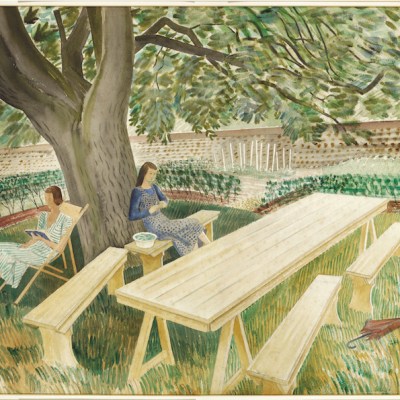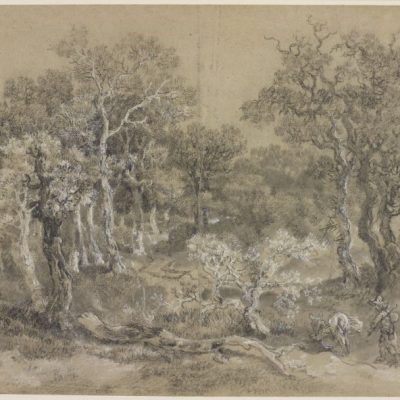John Singer Sargent turned 44 in 1900 and had itchy feet. He was at the height of his success as a painter of society portraits, but yearned to escape his studio and be free of the limitations of commissioned work. So he packed his bags and set off for warmer climes. Sketching expeditions in summer and autumn to Southern Europe, the Alps and the Middle East would become a regular feature of his life for the next two decades. He painted the places he visited, his travelling companions and the people he encountered. His preferred medium was watercolour because it was portable and practical, allowing him to sketch rapidly, en plein air, whatever subject caught his eye.
The Church of Santa Maria della Salute, Venice (c. 1904–09). John Singer Sargent. Calouste Gulbenkian Foundation, Lisbon. Photo: Catarina Gomes Ferreira

The paintings he produced on these expeditions are now the subject of an exhibition at the Dulwich Picture Gallery: ‘Sargent: The Watercolours’. It brings together 80 of the best examples, out of over 2,000 watercolours he made during these uninhibited bouts of creativity.
They speak of the breezy, carefree existence of a gentleman of leisure: gondolas bobbing on the Venetian lagoon, elegant ladies reposing in Alpine meadows, the sunlit courtyards of Mediterranean villas. Even the outbreak of war in 1914 does not appear to have significantly changed his approach. Parts of the Continent were now closed to him, but new opportunities arose when he was commissioned as an official war artist and sent to France. Here he painted kilted Scottish soldiers reclining in meadows, or tranquil scenes that allude to the conflict: the ruined gates of a chateau in Ransart, or the bomb-damaged interior of a mill in Arras. None of the watercolours included in this show depict the horrors of, say, Gassed, Sargent’s most famous war painting.
Highlanders Resting at the Front (1918), John Singer Sargent. Fitzwilliam Museum, Cambridge
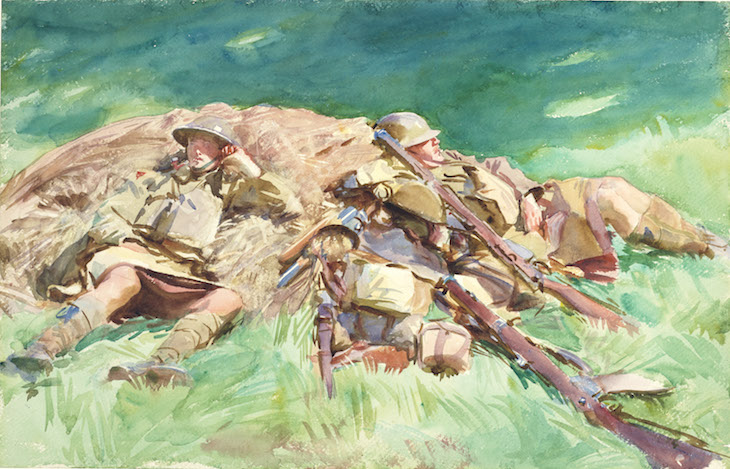
After his death critics were quick to dismiss his watercolours as little more than travel souvenirs, technically accomplished, but not to be taken seriously. This attitude was part of a wider marginalisation of watercolour painting in this period, a critical disregard addressed by the British Museum’s current exhibition, ‘Places of the Mind: British Watercolour Landscapes 1850–1950’ (until 27 August), which includes a number of works by Sargent. The Dulwich show offers a similar reassessment, emphasising the importance of watercolour sketching in reinvigorating Sargent’s creativity during this watershed point of his career, and also revealing a discernibly modern aesthetic in these works.
The exhibition is organised around simple themes: Landscape, Cities and Figures. But it starts with a more abstract idea – ‘Fragments’ – which provides the key to what follows. Included in this category are architectural studies and sketches of outdoor subjects seen from unconventional viewpoints. ‘Enormous views and huge skies do not tempt me,’ Sargent said, and his watercolour compositions reflect this, focusing on incidental details or adopting an oblique, glancing perspective. It was an observational approach informed by the visual conventions of photography, with its abrupt cropping of the image, and spontaneous, momentary way of looking.
The Fountain, Bologna (c. 1906), John Singer Sargent. Private collection
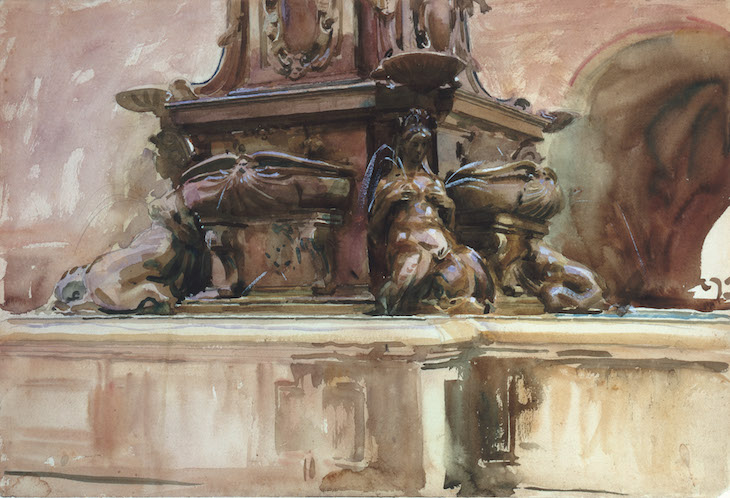
Take, for example, two studies he made of fountains. In The Fountain, Bologna (1908) he sliced off the main feature of the monument, Giambologna’s statue of Neptune, to concentrate on the ornate sculptural details around the base. Working with a limited palette of browns and purples, he created a tonal study that conveys a strong sense of the fountain’s physical presence, but at the same time is near to dissolving into indistinctness. Similarly, for Spanish Fountain (1912), he framed just the lower part of the structure. Painting the subject under strong sunlight, he concentrated on capturing the appearance of the rippling surface of the water and the reflected light on the underside of the basin. It is a bravura piece, visually complex, but surprisingly unlaboured in its execution. The reflections on the basin, for example, are rendered with just a few dashed lines of white gouache.
The Spanish Fountain, 1912, by Sargent The Spanish Fountain, 1912. Sargent, John Singer (American, 1856-1925). Graphite, watercolour and gouache on paper, height 533 mm, width 349 mm, 1912.
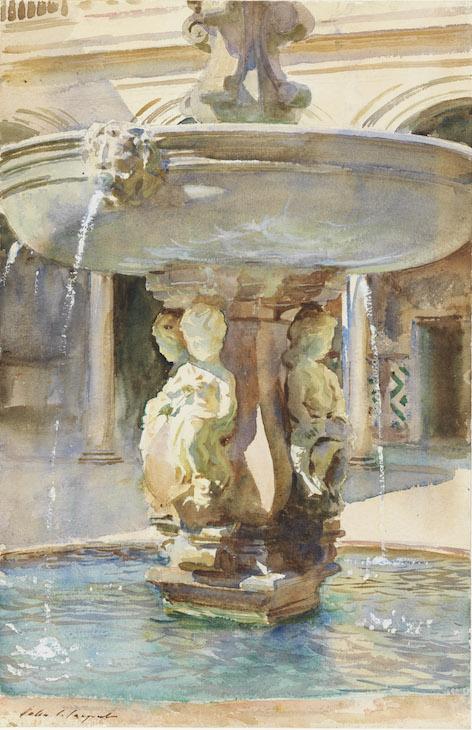
Sargent’s watercolour technique is always dazzling. He worked quickly, laying down broad, wet washes and thick stripes of pigment, often overlapping contrasting colours. But the apparent haphazardness of his brushwork belies his mastery of tone, form and composition. His methods were not always textbook: for example, the gleaming highlight on the dome in The Church of Santa Maria della Salute, Venice (c. 1904–09) is rendered with a thick blob of gouache impasto.
The best is left until last, with Sargent’s most audacious watercolours grouped in the final room, under the title ‘Figures’. Sargent was primarily a painter of people, so it is no surprise that his most innovative watercolours are of human subjects. The twisting pose and dramatic foreshortening of The Lady with the Umbrella (1911) lift it above straightforward prettiness. Flowing lines of wet pigment lead the eye on a journey across the silky surface of the sitter’s dress. In his double portrait of Miss Eliza Wedgwood and Miss Sargent Sketching (c. 1905–14), loose and expressive brushwork resolves into a touchingly affectionate characterisation of his sister and her friend.
The Lady with the Umbrella (1911), John Singer Sargent. Museu de Montserrat, Barcelona. Photo: © Dani Rovira

The thematic approach means there is little opportunity to contextualise these works in Sargent’s broader career. His experiences as a war artist are skimmed over, for example. We also gain little insight into his personal life. The exhibition ends enigmatically with Nude Man Lying on a Bed (c. 1917), an intimate, candid study of a young man lying on crumpled sheets smoking a cigarette. The curators are disappointingly coy about dealing with the implications of this image, and what it might suggest about Sargent’s inscrutable sexual identity.
These are, however, minor quibbles. The show is all about the watercolours, which stand out as exhilarating feats of painterly prowess and immensely enjoyable works of art.
‘Sargent: The Watercolours’ is at Dulwich Picture Gallery, London, until 8 October.

